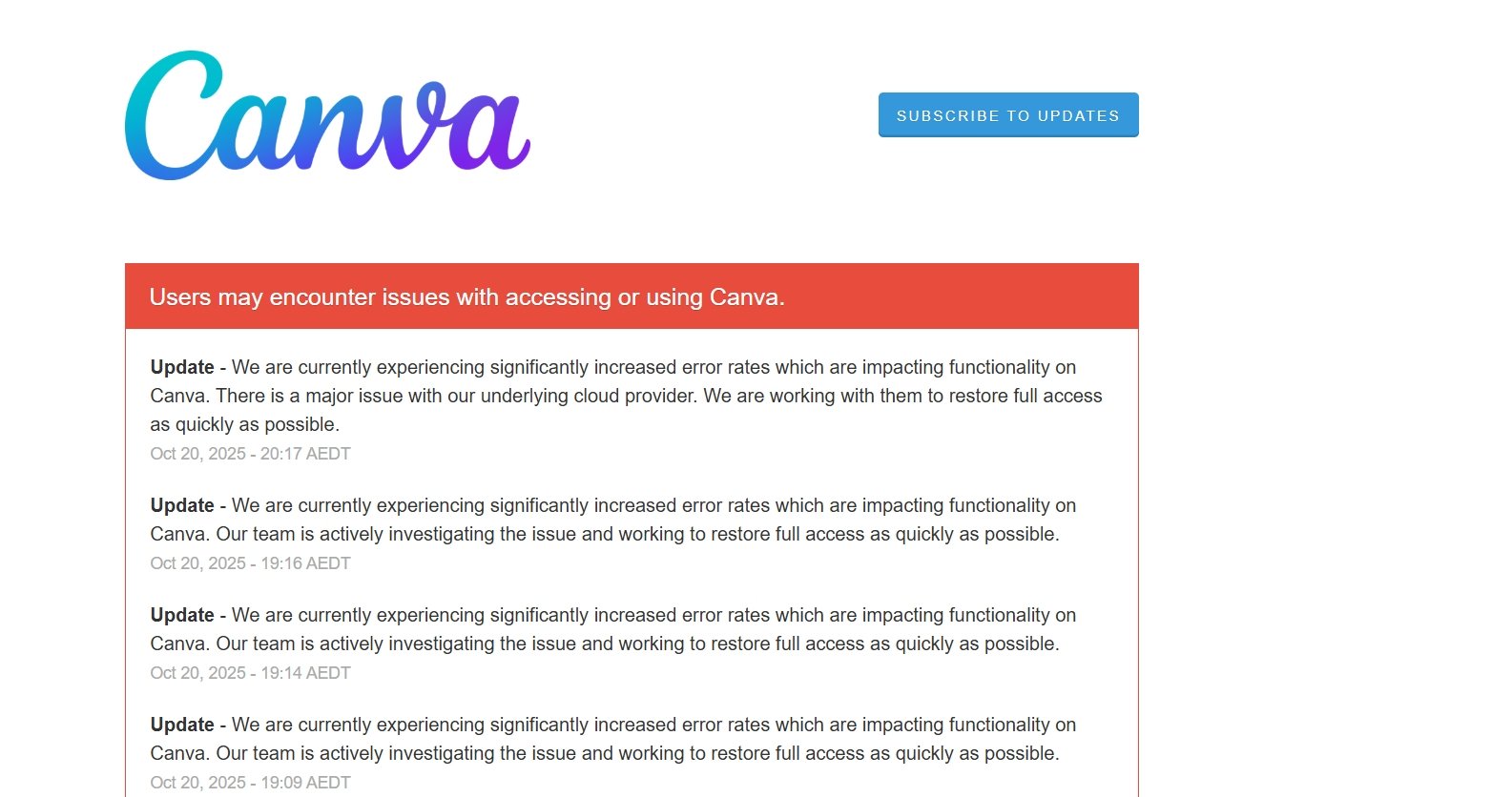Canva Is Down– Millions of users around the world faced sudden disruptions as Canva, Snapchat, Signal, Perplexity, Duolingo, and OpenAI all went offline simultaneously on Monday. This unexpected downtime left professionals, students, and creators stranded — unable to access their most essential digital tools. The root cause? A prominent Amazon Web Services (AWS) outage has disrupted the digital infrastructure that powers much of today’s internet.
Massive Global Outage Hits Major Internet Platforms
The widespread outage affected not just social media and design platforms but also several enterprise-grade systems and cloud-dependent services. Platforms like Amazon, Prime Video, Spotify, Coinbase, Zoom, Reddit, and even AI tools like Anthropic’s Claude reported disruptions or complete service failures.
According to reports from Down Detector, thousands of users began flagging issues as early as Monday morning (UTC). By afternoon, reports surged, particularly from North America and Europe, where AWS’s US-East-1 (Northern Virginia) data center region serves as a backbone for countless companies.
AWS later confirmed the issue, citing “increased error rates and latency across multiple AWS services.” The company’s initial assessment pointed to internal connectivity issues within Amazon DynamoDB and Amazon Elastic Compute Cloud (EC2) — two critical systems that support large-scale cloud operations.
AWS: The Cloud Backbone Behind the Internet
For many, the scale of this incident highlights a stark reality — AWS powers much of the modern internet. From startups to tech giants, AWS hosts, processes, and delivers billions of daily requests. Its EC2 platform runs virtual servers for major businesses, while DynamoDB provides real-time database management for mobile apps, AI tools, and content platforms.
When AWS experiences an outage, it doesn’t just affect Amazon’s internal ecosystem — it cascades across the global web. Apps like Canva and Duolingo, which rely heavily on AWS’s cloud infrastructure for both frontend and backend operations, become inaccessible almost instantly.
In a brief statement, an AWS spokesperson acknowledged the disruption, stating:
“We are actively investigating the root cause of the elevated error rates and working to restore normal operations as quickly as possible.”
How Canva and Other Services Were Impacted

-
Canva Users Left in Limbo
Millions of Canva users reported being unable to access their dashboards, load design templates, or download projects. For many professionals and social media managers, this downtime disrupted marketing campaigns and content schedules. Canva acknowledged the outage on its status page, confirming that AWS issues were affecting its servers.
-
Snapchat and Signal Messaging Delays
Social apps like Snapchat and Signal faced message delivery delays and connection drops. Signal’s official X (Twitter) account confirmed ongoing difficulties, noting that “some users may be unable to send or receive messages” while engineers worked on restoring full service.
-
Perplexity and OpenAI Downtime
AI-powered platforms like Perplexity AI and OpenAI ChatGPT saw interruptions, preventing users from generating or accessing AI responses. OpenAI’s service status page showed elevated error reports linked to its AWS dependencies.
-
Duolingo and E-Learning Halt
Popular learning platform Duolingo confirmed that users faced login and lesson-sync issues. Students relying on the app for daily practice streaks expressed frustration online, as the platform’s servers were unable to fetch lesson data during the AWS outage.
Coinbase, Zoom, and Spotify Among Affected Companies
While the focus remained on Canva and other consumer platforms, financial and communication services were also hit hard. Coinbase, the major cryptocurrency exchange, reported partial downtime. The company attributed the problem directly to the AWS failure, ensuring that “funds remain safe” while backend systems were being restored.
Zoom and Spotify users experienced intermittent connectivity, buffering, and login failures. Several Reddit communities also reported page-load errors and missing posts during the outage window.
Amazon Web Services Faces Growing Scrutiny
This outage isn’t an isolated event. AWS has experienced several large-scale disruptions in recent years — particularly in its North Virginia (us-east-1) region. Each incident raises questions about the resilience and decentralization of cloud computing infrastructure.
Analysts have long pointed out that over-reliance on a single cloud provider poses significant risks. As one of the “Big Three” cloud players (alongside Microsoft Azure and Google Cloud), AWS powers nearly 33% of the global cloud market. When it stumbles, the ripple effects are immediate and global.
Tech experts suggest that the growing interdependence of digital platforms has made such outages more severe. Many SaaS (Software as a Service) products are layered on top of AWS’s ecosystem — meaning one single-point failure can paralyze dozens of apps simultaneously.
What AWS Is Doing to Fix It
AWS engineers have been working through the affected region’s network routing and storage layers to stabilize services. Initial reports suggest that internal communication failures between EC2 instances triggered cascading performance degradation across multiple dependent services.
The company has assured customers that systems are gradually recovering. Status updates indicate improvements in response times and successful restoration of DynamoDB queries. Full resolution, however, might take several hours as cached data and dependent applications sync back online.
The Broader Impact on Businesses and Users
The incident serves as a reminder of how deeply cloud computing shapes our daily digital life. From small content creators designing in Canva to billion-dollar fintech firms managing real-time transactions, the outage exposed how interconnected and fragile modern web infrastructure can be.
Many companies are now revisiting multi-cloud strategies — distributing workloads across AWS, Azure, and Google Cloud — to reduce dependence on a single provider. For users, the takeaway is simpler: occasional downtime is inevitable in a world where nearly every app relies on shared digital backbones.
Social Media Reactions: #CanvaDown and #AWSOutage Trend Globally
As platforms went dark, hashtags like #CanvaDown, #SnapchatDown, and #AWSOutage dominated X (formerly Twitter) trends. Users worldwide shared screenshots, memes, and frustration over the simultaneous failure of so many essential apps. Within hours, tech influencers and engineers were dissecting AWS’s architecture and debating the future of cloud reliability.
Despite the inconvenience, the tech community’s response highlighted one thing — AWS remains the invisible power behind much of our online life, and when it falters, the entire internet feels it.
Conclusion: The Need for Cloud Resilience
The Canva and AWS outage underscores a critical truth — the digital world runs on shared infrastructure that’s both powerful and vulnerable. While AWS continues to be a cornerstone of modern technology, this incident proves the urgent need for better redundancy, transparent communication, and multi-cloud failovers.
As AWS gradually restores normal operations, companies are expected to review their disaster recovery protocols to prevent similar global disruptions in the future. For now, users can only wait for their favorite apps — from Canva to Signal — to return to full functionality.
AITeam is the dedicated editorial team of Android Infotech, consisting of experts and enthusiasts specialized in Android-related topics, including app development, software updates, and the latest tech trends. With a passion for technology and years of experience, our team aims to provide accurate, insightful, and up-to-date information to help developers, tech enthusiasts, and readers stay ahead in the Android ecosystem.
For more about our team, visit our About Us page.




Leave a Reply